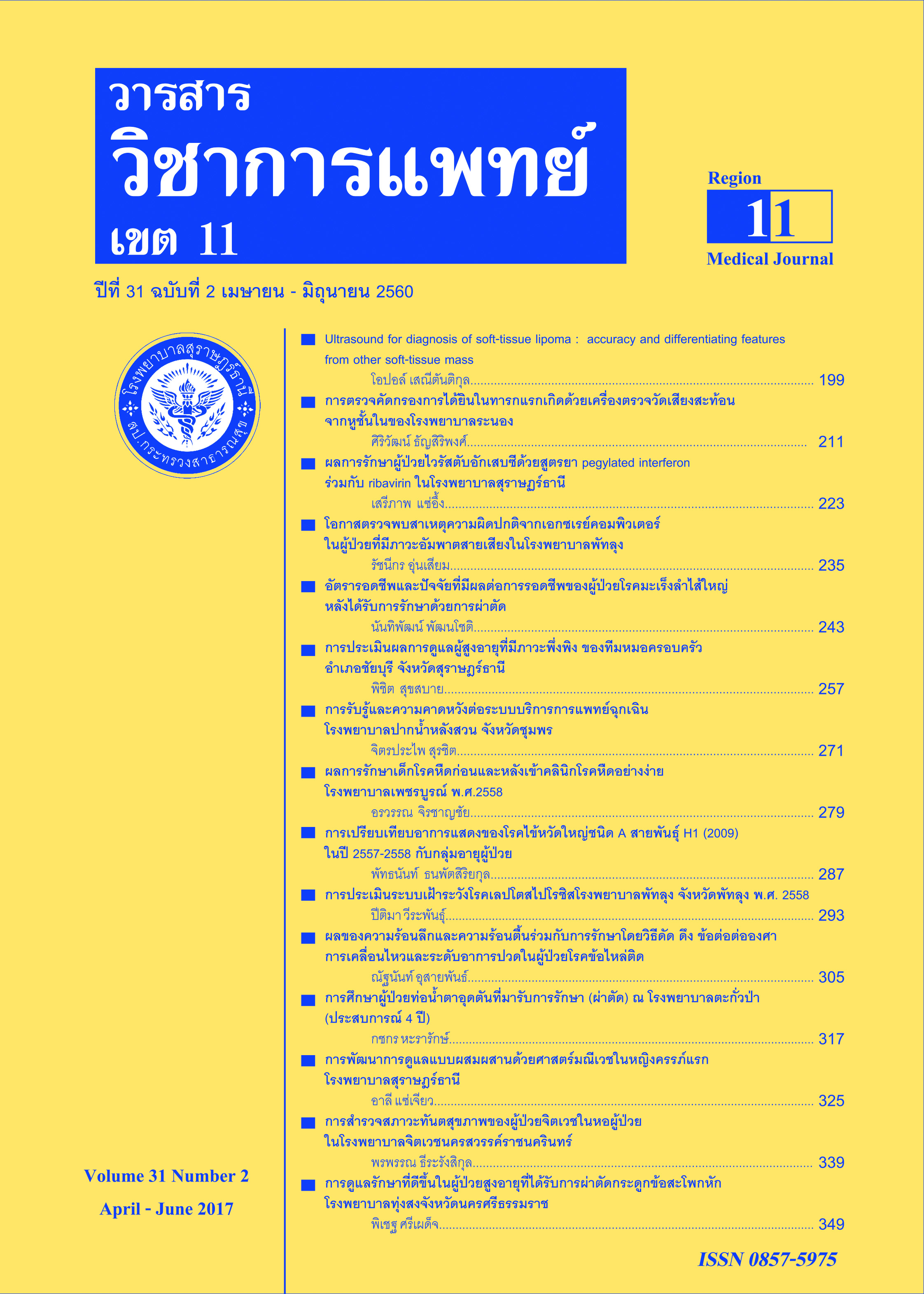Effects of deep and superficial heating with joint mobilization therapy on range of motion and visual analog scale in patients with frozen shoulder.
Keywords:
Frozen shoulder patients, Joint Mobilization, Hot pack, Short Wave Diathermy, Range of motion, Visual analogue scalesAbstract
Background and Objective : The question of whether deep (Short Wave Diathermy:SWD)or superficial heating (Hot pack: HP) therapy along with joint mobilization improve clinical outcome in range of motion and decrease visual analogue scales (VAS) in patients with frozen shoulder still remains in question. This research aims to investigated the effectiveness of SWD and HP with joint mobilization therapy on ranges of motion (ROM) and VAS in both male and female frozen shoulder patients at Suratthani Hospital.
Methods : 40 patients with frozen shoulder between the age of 30-60 at Suratthani Hospital are divided into 2 groups, the group which HP and SWD heating therapy, and treated with respective heating therapy with joint mobilization for 5 consecutive weeks with range of motion in shoulder that are less or equal to the ROM when raising shoulder flexion 90 degrees, abduction 80 degree, internal and external rotation 40 degrees. The VAS during such movements must be less than 5 under the condition that the patients with frozen shoulder had never received any physical therapy prior to the study.
Results : The study monitored the patients from 2 groups, HP with joint mobilization of 20 patients, 12 males and 8 females, with the average age of 48.2 which received therapy using HP with joint mobilization and 20 patients, 14 males and 6 females, with the average age of 51.3, which received therapy using SWD with joint mobilization. The study within each group shows that there is a significant statistical increase after the treatments using HP and
SWD with joint mobilization therapy were employed compared to the ranges of motion in shoulder flexion, abduction, internal and external rotation prior to the treatment. When comparing 2 groups,the study shows that there is no significant statistical difference in shoulder flexion, abduction, internal and external rotation. Moreover, there here was no significant difference in VAS after the treatments between the HP and SWD with joint mobilization group, both within and between the groups.
Conclusion : The research shows that after treatments using HP and SWD with joint mobilization are the factor in the increase ROM in shoulder in patients with frozen shoulder.
References
2. Park C, Lee S, Yi CW, Lee K. The effects of extracorporeal shock wave therapy on frozen shoulder patients' pain and functions. Journal of physical therapy science. 2015 ;27(12):3659-61.
3. Yeole LU, Dighe DP, Gharote MD, Panse SR, Shweta AK. Effectivenness of movement with mobilization in adhesive capsulitis of shhoulder: randomized controlled trial. Indian Journal of Medical Research and Pharmaceutical Sciences. 2017;4(2):1-8.
4. Lee BK. Effects of the combined PNF and deep breathing exercises on the ROM and the VAS score of a frozen shoulder patient: Single case study. Journal of exercise rehabilitation. 2015;11(5):276-81.
5. Lewis J. Frozen shoulder contracture syndrome Aetiology, diagnosis and management. Manual therapy. 2015 ;20(1):2-9.
6. Clement RG, Ray AG, Davidson C, Robinson CM, Perks FJ. Frozen shoulder : long-term outcome following arthrographic distension. Acta orthopaedica Belgica. 2013 ;79(4):368-74.
7. Reid SA, Rivett DA, Katekar MG, Callister R. Comparison of mulligan sustained natural apophyseal glides and maitland mobilizations for treatment of cervicogenic dizziness: a randomized controlled trial. Physical therapy. 2014 ;94(4):466-76.
8. Leung MS, Cheing GL. Effects of deep and superficial heating in the management of frozen shoulder. Journal of rehabilitation medicine. 2008 ;40(2):145-50.
9. Lentell G, Hetherington T, Eagan J, Morgan M. The use of thermal agents to influence the effectiveness of a low-load prolonged stretch. The Journal of orthopaedic and sports physical therapy. 1992 ;16:200-7.
10. Robertson VJ, Ward AR, Jung P. The effect of heat on tissue extensibility: a comparison of deep and superficial heating. Archives of physical medicine and rehabilitation. 2005 ;86(4):819-25.
11. Humayun I, A., Basit A, Kiran A, Syed H, A., Afsheen A, Sitwat Z. Physical Therapy When Used Along With Electrical Modalities In Order To Improve the Range Of Motion in Frozen Shoulder Is More Beneficial Than Using Modalities Alone. Institute of Interdisciplinary Business Research. 2013;12(4):336-44.
12. Caporossi L, S., Goyal M, Bhattacharjee S, Goyal K. Combined Effect of End Range Mobilization (ERM) and Mobilization with Movement (MWM) Techniques on Range Of Motion and Disability in Frozen Shoulder Patients: A Randomized Clinical Trial. Journal of Exercise Science and Physiotherapy. 2013;9(2):74-82.
13. Vastamäki HA. The long-term outcome of frozen shoulder. 2015:1-78.
14. Vermeulen HM, Rozing PM, Obermann WR, le Cessie S, Vliet Vlieland TP. Comparison of highgrade and low-grade mobilization techniques in the management of adhesive capsulitis of the shoulder: randomized controlled trial. Physical therapy. 2006 ;86(3):355-68.
15. วิชชุดา. อ, ยงยุทธ. ศ. Frozen shoulder. Khon kaen Medical Journal. 2003;18(3):59-70.
16. Dobsicek Trefna H, Crezee J, Schmidt M, Marder D, Lamprecht U, Ehmann M, et al. Quality assurance guidelines for superficial hyperthermia clinical trials : II. Technical requirements for heating devices. Strahlentherapie und Onkologie : Organ der Deutschen Rontgengesellschaft [et al]. 2017 ;193(5):351-66.
17. Ali SA, Khan M. Comparison for efficacy of general exercises with and without mobilization therapy for the management of adhesive capsulitis of shoulder An interventional study. Pakistan journal of medical sciences. 2015 ;31(6):1372-6.
18. Johnson AJ, Godges JJ, Zimmerman GJ, Ounanian LL. The effect of anterior versus posterior glide joint mobilization on external rotation range of motion in patients with shoulder adhesive capsulitis. The Journal of orthopaedic and sports physical therapy. 2007 ;37(3):88-99.
19. Al Dajah SB. Soft Tissue Mobilization and PNF Improve Range of Motion and Minimize Pain Level in Shoulder Impingement. Journal of physical therapy science. 2014 ;26(11):1803-5.






